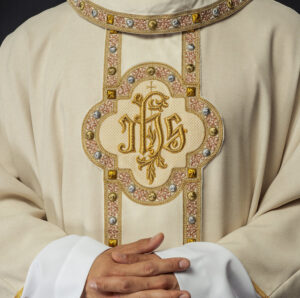Liturgical vestments, with their richness of colors and decorations, are not mere garments. They are a visual language that speaks of faith, tradition, and symbolism. Understanding the designs that adorn these vestments means entering a world of profound meanings, capable of enriching our spiritual experience and our participation in celebrations.
The Symbolism of Liturgical Colors
Color is one of the most evident and significant elements of liturgical vestments. Each color is associated with a particular period of the liturgical year or a specific celebration, expressing a different aspect of the Christian faith:
- White: Symbol of purity, joy, and glory, white is used during Eastertide, Christmastide, feasts of the Lord (except those of the Passion), feasts of the Virgin Mary, angels, and non-martyr saints.
- Red: Represents blood, passion, divine love, and martyrdom. Red is worn during Palm Sunday, Good Friday, Pentecost, feasts of the apostles, and martyr saints.
- Green: Symbolizes hope and eternal life. Green is the color of Ordinary Time, the period of the liturgical year when we meditate on the life of Christ and await his return.
- Violet: Indicates penance, waiting, and preparation. Violet is used during Advent and Lent.
- Black: Traditionally associated with mourning and the commemoration of the deceased, black may be used during Requiem Masses.
- Rose: A less common color, rose is a sign of joy and mitigated hope. It can be used on the Third Sunday of Advent (Gaudete) and the Fourth Sunday of Lent (Laetare).
Decorative Designs: An Alphabet of Faith
Besides colors, liturgical vestments are often adorned with a variety of decorative designs, each with its specific meaning. These designs can be embroidered, woven, or painted on the garment, transforming it into a work of art that tells biblical stories, expresses theological concepts, and celebrates holiness.
Christological Symbols
Christological symbols are those that refer directly to Jesus Christ:
- Lamb of God (Agnus Dei): Represents Jesus Christ as the sacrificial victim for the salvation of humanity. Often depicted with a cross or a banner.
- Christogram (IHS, XP): Monograms formed from the first letters of Jesus’ name in Greek (ΙΗΣΟΥΣ).
- Fish (Ichthys): Greek acronym that means “Jesus Christ, Son of God, Savior.”
- Alpha and Omega: The first and last letters of the Greek alphabet, symbolizing Christ as the beginning and end of all things.
- Sacred Heart: Represents the infinite love of Christ for humanity.
- The Cross: The most important symbol of Christianity, recalling Christ’s sacrifice for the redemption of the world.
Marian Symbols
Marian symbols are those that refer to the Virgin Mary, mother of Jesus:
- Lily: Symbol of purity and virginity of Mary.
- Star: Represents Mary as “Star of the Morning,” announcing the arrival of Christ.
- Crown: Symbol of Mary’s royalty as Queen of Heaven and Earth.
- Marian Monogram (M, AM): Represents the name of Mary.
- Rose: Symbol of Mary’s love and beauty.
Eucharistic Symbols
Eucharistic symbols are those that refer to the Eucharist, the sacrament of the Body and Blood of Christ:
- Grapes and Wheat: Represent the bread and wine used in the Eucharist, which become the Body and Blood of Christ.
- Chalice and Host: Direct symbols of the Eucharist.
- Pelican: According to an ancient legend, the pelican wounds its chest to feed its young with its own blood. For this reason, it has become a symbol of Christ sacrificing himself for the salvation of humanity.
Other Important Symbols
Besides Christological, Marian, and Eucharistic symbols, there are many other decorative designs that may be present on liturgical vestments:
- Angels: Messengers of God and celestial servants.
- Saints: Represented with their specific attributes (e.g., Saint Peter with keys, Saint Paul with a sword).
- Instruments of the Passion: Symbols of Christ’s torment (e.g., crown of thorns, nails, lance).
- Dove: Symbol of the Holy Spirit.
- Tree of Life: Symbol of eternal life and the connection between heaven and earth.
- Flowers and Leaves: Often used as decorative elements, they can have specific symbolic meanings (e.g., the palm as a symbol of martyrdom).
- Geometric Designs: Circles, squares, triangles, and other geometric shapes can represent theological concepts such as the Trinity, divine perfection, and cosmic order.
The Importance of Cultural and Artistic Context
The interpretation of designs on liturgical vestments cannot ignore the cultural and artistic context in which they were created. The style, materials, and techniques used reflect the artistic traditions of a specific historical period and a specific geographical region. For example, an ornament made in the Byzantine style will have different characteristics from one made in the Gothic or Baroque style.
The Role of Sacred Art
Liturgical vestments are a form of sacred art, an art that aims to uplift the spirit, inspire prayer, and communicate faith. Through the beauty of colors, the richness of materials, and the depth of symbols, liturgical vestments help us connect with the mystery of God and live our faith experience more fully.
How HaftinaUSA.com Contributes to the Tradition
At HaftinaUSA.com, we understand the importance of this rich tradition and are committed to offering a wide range of liturgical vestments that respect the sacredness and beauty of each celebration. From classic embroidered ornaments to modern and minimalist ones, each garment is made with care and attention to detail, using high-quality materials and artisanal techniques. Our goal is to provide priests and ministers of worship with the tools necessary to celebrate the liturgy with dignity and devotion, honoring the tradition and inspiring faith.
Practical Tips for Interpretation
Here are some practical tips for interpreting the designs on liturgical vestments:
- Observe carefully: Pay attention to the colors, symbols, and decorative designs on the garment.
- Consider the liturgical context: Keep in mind the time of the liturgical year or the specific celebration.
- Research the meaning of symbols: Consult books, websites, or experts to deepen your knowledge of Christian symbols.
- Reflect on the message: Ask yourself what message the liturgical vestment wants to communicate and how it can enrich your faith experience.
- Appreciate the beauty: Let yourself be inspired by the beauty of sacred art and its ability to uplift the spirit.
Liturgical Vestments and Accessories: An Expression of Faith and Devotion
The choice of a liturgical vestment, whether it is a sacred vestment for the priest or an accessory for the altar, represents an act of faith and devotion. Every detail, from the type of fabric to the embroidery, contributes to creating an atmosphere of sacredness and respect during celebrations.
The Importance of Material Quality
The quality of the materials used to make liturgical vestments is fundamental. Fine fabrics such as silk, brocade, and velvet confer elegance and solemnity, while gold and silver thread embroidery adds a touch of refinement. Care in the choice of materials is not only an aesthetic matter but also a sign of respect for the sacred.
The Value of Craftsmanship
Many liturgical vestments are handmade by skilled artisans who pass on the ancient techniques of embroidery and weaving from generation to generation. This craftsmanship gives added value to the garment, making it a unique and precious piece. Choosing a handmade garment means supporting local craftsmanship and preserving a cultural heritage of inestimable value.
The Evolution of Liturgical Designs Over Time
The decorative designs of liturgical vestments have evolved over the centuries, reflecting the cultural and artistic changes of different eras. From simple early Christian symbols to elaborate Baroque decorations, each historical period has left its mark on sacred art. Studying the evolution of liturgical designs allows us to better understand the history of the Christian faith and its relationship with culture.
Conclusion: An Invitation to Contemplation
Interpreting the designs on liturgical vestments is an invitation to contemplation and prayer. It is a way to connect with the richness of the Christian tradition and to deepen our understanding of the faith. The next time you participate in a liturgical celebration, carefully observe the vestments of the priest and ministers of worship. You will discover a world of hidden meanings, capable of enriching your spiritual experience and bringing you closer to God.

